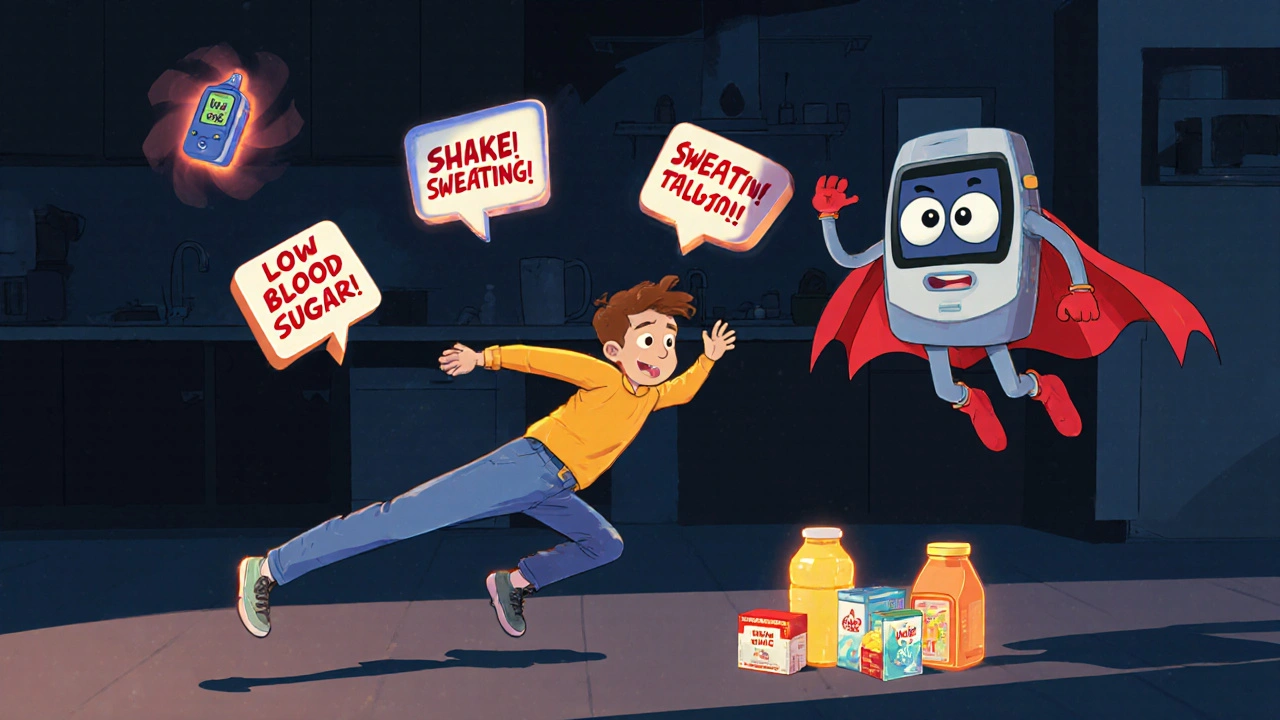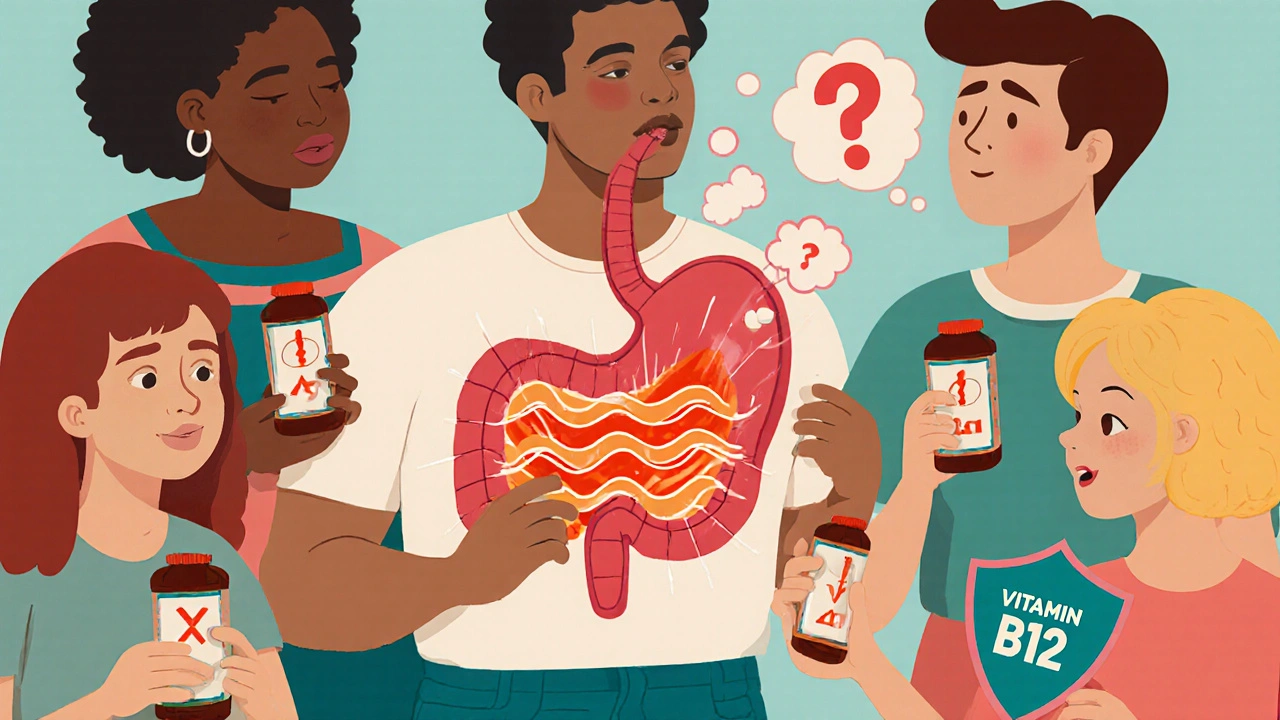Managing diabetes isn’t just about checking blood sugar levels or counting carbs. For millions of people, it’s also about dealing with the unexpected side effects of the very drugs meant to help them. Diabetes medication side effects can throw off glucose control, make daily life harder, and even lead to stopping treatment altogether. About half of people with Type 2 diabetes stop taking their meds within the first year-not because the drugs don’t work, but because the side effects are too much to handle.
Metformin: The First-Line Drug With a Gastrointestinal Price
Metformin is the most prescribed diabetes medication in the world. It’s cheap, effective, and doesn’t cause low blood sugar. But for 20 to 30% of users, it comes with a gut punch. Heartburn, nausea, vomiting, bloating, and diarrhea are common, especially when starting the drug or increasing the dose. Many people quit because they think their stomach issues are unrelated to the pill-until they switch to the extended-release version.Extended-release metformin (like Glucophage XR or Fortamet) cuts those side effects by nearly half. Taking it with food also helps. But there’s another hidden risk: long-term use. After four or more years, up to 10% of people develop a vitamin B12 deficiency. That means fatigue, dizziness, numbness in hands or feet, and even memory problems. Doctors rarely check B12 levels unless symptoms show up. The fix? A daily 1,500 mcg supplement. Simple. Cheap. Life-changing for those affected.
Sulfonylureas: The Hypoglycemia Trap
Drugs like glipizide (Glucotrol) and glyburide (Amaryl) force the pancreas to pump out more insulin. They’re effective at lowering blood sugar-but they can drop it too low. About 15 to 20% of users experience hypoglycemia, often without warning. Symptoms? Shakiness, sweating, confusion, fast heartbeat. In older adults, it can lead to falls, seizures, or even heart attacks.The 15-15 rule is the go-to fix: eat 15 grams of fast-acting sugar (like juice or glucose tablets), wait 15 minutes, check your blood sugar again. Repeat if needed. But prevention is better than reaction. Continuous glucose monitors (CGMs) reduce severe low blood sugar episodes by 40%. Many patients don’t realize their doctor should have warned them about this risk before prescribing sulfonylureas. A 2022 Mayo Clinic survey found that 28% of patients felt unprepared for hypoglycemia-and it was the most disruptive side effect in their daily lives.
SGLT2 Inhibitors: Weight Loss With a Hidden Cost
Jardiance, Farxiga, Invokana-these drugs work by making your kidneys flush out extra sugar through urine. The result? Lower blood sugar, weight loss (2-3 kg in six months), and reduced heart failure risk. But there’s a trade-off.Five to ten percent of users get urinary tract infections. Women are more likely to get yeast infections-4 to 6% of them. Men get them too, but less often (1-2%). One Reddit user, u/DiabeticDad, wrote: “Jardiance dropped my A1c from 8.2 to 6.8-but I had three UTIs in six months. I switched to Victoza.”
These drugs also carry rare but terrifying risks: Fournier’s gangrene (a deadly genital infection), ketoacidosis (even with normal blood sugar), and a slightly higher chance of amputation with canagliflozin. The FDA added black box warnings for these in 2017 and 2018. Still, they’re recommended for people with heart disease or kidney problems. The key? Stay hydrated. Drink water. Practice good hygiene. Avoid sugary drinks. Cranberry supplements may help prevent UTIs, though evidence is mixed.

Thiazolidinediones: The Heart Risk That Was Ignored
Actos and Avandia were once popular for improving insulin sensitivity. But Avandia (rosiglitazone) was pulled from most markets after a 2007 study linked it to a 33% higher risk of heart attack. Even now, it’s restricted in the U.S. and banned in Europe. Actos (pioglitazone) is still available, but it causes fluid retention-leading to swelling in the legs and weight gain. For people with heart failure, it can make things worse. The American Association of Clinical Endocrinologists warns against using these drugs in anyone with Class III or IV heart failure.Weight gain is another issue. People on TZDs typically gain 2 to 5 kg. That’s the opposite of what most Type 2 diabetics need. And while they lower A1c, the risks often outweigh the benefits. Fewer doctors prescribe them now-but if you’re still on one, ask why. There are safer, more effective options.
Alpha-Glucosidase Inhibitors: The Gas and Bloat Problem
Precose and Glyset slow down how fast your body digests carbs. That helps prevent blood sugar spikes after meals. But the undigested carbs don’t disappear-they go straight to your colon, where bacteria feast on them. The result? Gas, bloating, cramps, and diarrhea. Up to 30% of users can’t tolerate it.These drugs are rarely used today. They’re less effective than metformin or SGLT2 inhibitors, and the side effects are hard to live with. Most doctors only consider them if someone can’t take other drugs. If you’re on one and struggling, talk to your provider. There’s almost always a better alternative.
Choosing the Right Med: It’s Not One-Size-Fits-All
There’s no perfect diabetes drug. Each has trade-offs. Metformin is safe for most but tough on the stomach. Sulfonylureas cause lows. SGLT2 inhibitors help the heart but increase infections. TZDs harm the heart and cause weight gain.What matters most is matching the drug to your life. If you’re overweight and have heart disease, an SGLT2 inhibitor might be ideal. If you’re older with kidney issues, metformin is safer than SGLT2 drugs. If you’re prone to low blood sugar, avoid sulfonylureas. If your stomach can’t handle pills, try extended-release metformin or a GLP-1 agonist like Victoza or Ozempic.
Doctors used to focus only on A1c. Now, they’re told to consider quality of life. A 2023 ADA guideline says: “The best medication is the one you can take consistently.” That means side effects aren’t just a footnote-they’re the deciding factor.

What You Can Do Right Now
- If you’re on metformin and have stomach issues, ask about the extended-release version.
- If you’re on any drug and feel dizzy, shaky, or tired, check your blood sugar. It might be low.
- If you’re on an SGLT2 inhibitor and get frequent UTIs, drink more water, wipe front to back, and talk to your doctor about prevention.
- Ask your doctor to check your B12 level if you’ve been on metformin for more than four years.
- If side effects are making you want to quit, don’t stop cold turkey. Talk to your provider. There’s almost always a way to adjust.
Many people think side effects are normal and just have to live with them. They’re not. There are better options, better timing, better formulations. Your treatment should fit your life-not the other way around.
What’s Coming Next
Newer drugs are being developed to reduce these problems. Fixed-dose combos like Xigduo XR (metformin + dapagliflozin) cut metformin’s stomach side effects by 25%. Researchers are working on next-gen TZDs that don’t cause swelling. And in the future, genetic testing may tell you before you even start a drug whether you’re likely to get severe side effects. For example, people with the ADL-1 gene variant are over three times more likely to have bad reactions to metformin.By 2030, glucose-responsive insulin and closed-loop systems may reduce the need for daily pills altogether. But for now, understanding your meds-and their downsides-is your best tool for staying in control.
Can diabetes medications cause low blood sugar?
Yes, but not all of them. Sulfonylureas (like glipizide) and insulin are the most likely to cause low blood sugar (hypoglycemia), with about 15-20% of users affected. Metformin, SGLT2 inhibitors, and GLP-1 agonists rarely cause it. If you’re on a drug that can cause lows, learn the 15-15 rule and carry fast-acting sugar. A continuous glucose monitor can help prevent severe episodes.
Why do some diabetes drugs cause weight gain?
Drugs that force your body to make more insulin-like sulfonylureas and TZDs-can cause weight gain. Insulin tells your body to store fat. SGLT2 inhibitors, on the other hand, make you lose sugar (and calories) through urine, which leads to weight loss. If weight gain is a concern, ask your doctor about metformin or SGLT2 inhibitors instead.
Is metformin safe long-term?
Yes, for most people. It’s been used for over 60 years and is considered the safest first-line treatment. But long-term use (over 4 years) can lower vitamin B12 levels in 5-10% of users. This can cause fatigue, nerve problems, or anemia. Ask your doctor for a B12 blood test if you’ve been on metformin for more than four years. A daily supplement of 1,500 mcg usually fixes it.
What should I do if I’m having bad side effects?
Don’t stop taking your medication without talking to your doctor. Many side effects can be managed-lowering the dose, switching to an extended-release version, or changing to a different drug. For example, if metformin gives you stomach pain, try the XR version. If you’re getting frequent yeast infections from an SGLT2 inhibitor, ask about switching to a GLP-1 agonist. Your provider should help you find a solution, not just tell you to “tough it out.”
Are newer diabetes drugs better than older ones?
Not always-but they often have better safety profiles. SGLT2 inhibitors and GLP-1 agonists not only lower blood sugar but also protect the heart and kidneys. Older drugs like sulfonylureas and TZDs carry more risks-like low blood sugar or heart failure. But newer drugs are more expensive. If you don’t have heart or kidney disease, metformin is still the best starting point for most people. The goal isn’t the newest drug-it’s the one that works for you with the fewest side effects.





One comment
Extended-release metformin is a game-changer for GI issues. I switched last year after six months of daily nausea. Took me three tries to find the right dose, but now I’m on 1000mg ER with breakfast and no problems. Also got my B12 checked - was at 180, started supplements, energy came back in two weeks. Doctors need to mention this more. It’s not ‘just stomach stuff’ - it’s a nutrient deficiency waiting to happen.
People think side effects mean they’re failing but really it just means the system isn’t matching their body. I was on sulfonylureas for two years, had three hypoglycemic episodes at work. One time I passed out in the breakroom. No one knew what happened. After switching to metformin + GLP-1, I haven’t had a single low. It’s not about willpower. It’s about matching the drug to the person.